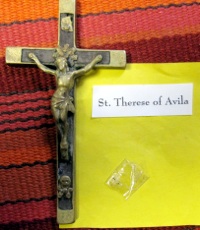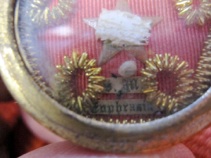HOLY RELICS



True Cross of our Lord Jesus Christ
The True Cross is the name for physical remnants which, by a Christian tradition, are believed to be from the cross upon which Jesus was crucified.
The Cross of Christ was not only a precious remembrance of Christ’s sufferings and death, but also a symbol closely associated with His sacrifice and the mystery of the Passion. It was, moreover, natural that it should be
According to post-Nicene historians, Socrates Scholasticus and others, the Empress Helena (c. AD 250 – c. AD 330), mother of Constantine, the first Christian Emperor of Rome, travelled to the Holy Land, dated by modern historians in AD 326-28, founding churches and establishing relief agencies for the poor. It was afterwards claimed, in the later fourth-century history by Gelasius of Caesarea followed by Rufinus’ additions to Eusebius’ Ecclesiastical History, that she discovered the hiding place of three crosses, believed to be used at the crucifixion of Jesus and the two thieves – St. Dismas and Gestas – who were executed with him, and that through a miracle it was revealed which of the three was the True Cross.
(Source: Catholic Encyclopedia and Wikipedia)
Tree from Mount Olive
(Agony in the Garden)
According to all four Gospels (from Matthew, Mark, Luke, and John), immediately after the Last Supper, Jesus took a walk and entered a grove of olive trees to pray (John 18:1). Matthew and Mark identified this place of prayer as Gethsemane. Jesus was accompanied by Peter, John, and James, whom he asked to stay awake and pray. He moved “a stone’s throw away” from them, where he felt overwhelming sadness and anguish, and said “My Father! If it is possible, let this cup of suffering be taken away from me. Yet I want your will to be done, not mine.” Then, a little while later, He said, “If this cup cannot be taken away, unless I drink it,your will be done.” (Matthew 26:39-42). He said this prayer three times, checking on the three apostles, between each prayer and finding them asleep. He comments: “The spirit is willing, but the flesh is weak”. An angel came from heaven to strengthen him. During his agony, as he prayed “his sweat fell to the ground like great drops of blood.” (Luke 22:44).
In the garden of Gethsemane, there are eight olive trees whose age is lost in antiquity. The garden is at the foot of the Mount of Olives in Jerusalem, the place where Jesus with his disciples, prayed the night before his crucifixion. Some botanists claim that they may be 3,000 years old. Josephus (a 1st-century Romano-Jewish historian) relates that Titus (a Roman Emperor) cut down all the trees in the siege of Jerusalem in 70 A.C.If these escaped destruction, they are the very contemporaries of Christ as they are Roman olive trees. If not, they are without a doubt the shoots of those under which Jesus Christ prayed that night of his agony. The Garden of Gethsemane (‘oil press’) lies at the foot of the Mount of Olives. On the opposite hill, city followed city, but this garden is still kept as it was in the time of Jesus, maybe with the same olive trees. St. John spoke of it as a garden over the Kidron Valley (John 18:1)
(Source: Wikipedia)






Bones of St. Joachim (Father of the Blessed Virgin Mary)
Sepulchre of St. John the Evangelist (one of Jesus’ original 12 apostles)
Bones of St. Stephen, Protomartyr
Bones of St. Venantius, Martyr
Cloak of St. Francis de Paula
Cloak of St. Charles Borromeo
Bones of St. Liborius, Bishop
Bones of St. Thomas Aquinas
Flesh of St. Vincent de Paul
St. Benoit (St. Benedict) (480 – 543)
Saint Benedict of Nursia is a Christian saint, honoured by the Roman Catholic Church as the patron saint of Europe and students.
Benedict founded twelve communities for monks at Subiaco, about 40 miles (64 km) to the east of Rome, before moving to Monte Cassino in the mountains of southern Italy. There is no evidence that he intended to found a religious order. The Order of St Benedict is of later origin and, moreover, not an “order” as commonly understood but merely a confederation of autonomous congregations.
Benedict’s main achievement is his “Rule”, containing precepts for his monks. It is heavily influenced by the writings of John Cassian (Christian theologian and a Scythian monk), and shows strong affinity with the Rule of the Master. But it also has a unique spirit of balance, moderation and reasonableness, and this persuaded most religious communities founded throughout the Middle Ages to adopt it. As a result, the Rule of Benedict became one of the most influential religious rules in Western Christendom. For this reason, Benedict is often called the founder of western Christian monasticism.
Rule of St. Benedict
Seventy-three short chapters comprise the Rule. Its wisdom is of two kinds: spiritual (how to live a Christocentric life on earth) and administrative (how to run a monastery efficiently). More than half the chapters describe how to be obedient and humble, and what to do when a member of the community is not. About one-fourth regulate the work of God (the Opus Dei). One-tenth outline how, and by whom, theRelic of St. Benoit monastery should be managed. And two chapters specifically describe the abbot’s pastoral duties.
(Source: Wikipedia)




St. Teresa of Avila (1515 – 1582)
Born in Avila, Spain, on March 28, 1515, St. Teresa was the daughter of a Toledo merchant and his second wife, who died when Teresa was 15, one of ten children. Shortly after this event, Teresa was entrusted to the care of the Augustinian nuns. After reading the letters of St. Jerome, Teresa resolved to enter a religious life. In 1535, she joined the Carmelite Order. She spent a number of relatively average years in the convent, punctuated by a severe illness that left her legs paralyzed for three years, but then experienced a vision of “the sorely wounded Christ” that changed her life forever.
From this point forward, Teresa moved into a period of increasingly ecstatic experiences in which she came to focus more and more sharply on Christ’s passion. With these visions as her impetus, she set herself to the reformation of her order, beginning with her attempt to master herself and her adherence to the rule.Gathering a group of supporters, Teresa endeavored to create a more primitive type of Carmelite. From 1560 until her death, Teresa struggled to establish and broaden the movement of Discalced or shoeless Carmelites. During the mid-1560s, she wrote the Way of Perfection and the Meditations on the Canticle. In 1567, she met St. John of the Cross, who she enlisted to extend her reform into the male side of the Carmelite Order. Teresa died in 1582.St. Teresa left to posterity many new convents, which she continued founding up to the year of her death. She also left a significant legacy of writings, which represent important benchmarks in the history of Christian mysticism. These works include the Way of Perfection and the Interior Castle. She also left an autobiography, the Life of Teresa of Avila.
St. Teresa of Avila (1515 – 1582)
Born in Avila, Spain, on March 28, 1515, St. Teresa was the daughter of a Toledo merchant and his second wife, who died when Teresa was 15, one of ten children. Shortly after this event, Teresa was entrusted to the care of the Augustinian nuns. After reading the letters of St. Jerome, Teresa resolved to enter a religious life. In 1535, she joined the Carmelite Order. She spent a number of relatively average years in the convent, punctuated by a severe illness that left her legs paralyzed for three years, but then experienced a vision of “the sorely wounded Christ” that changed her life forever.
From this point forward, Teresa moved into a period of increasingly ecstatic experiences in which she came to focus more and more sharply on Christ’s passion. With these visions as her impetus, she set herself to the reformation of her order, beginning with her attempt to master herself and her adherence to the rule.Gathering a group of supporters, Teresa endeavored to create a more primitive type of Carmelite. From 1560 until her death, Teresa struggled to establish and broaden the movement of Discalced or shoeless Carmelites. During the mid-1560s, she wrote the Way of Perfection and the Meditations on the Canticle. In 1567, she met St. John of the Cross, who she enlisted to extend her reform into the male side of the Carmelite Order. Teresa died in 1582.St. Teresa left to posterity many new convents, which she continued founding up to the year of her death. She also left a significant legacy of writings, which represent important benchmarks in the history of Christian mysticism. These works include the Way of Perfection and the Interior Castle. She also left an autobiography, the Life of Teresa of Avila.


